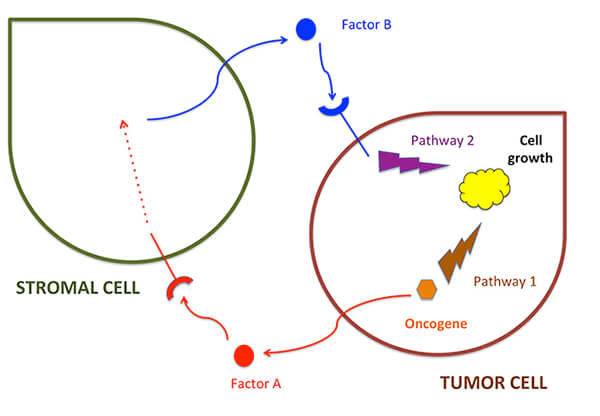Crosstalk between Cancer Cells and Neighboring Cells May Contribute to Tumor Growth
, by NCI Staff
Pancreatic tumor cells and neighboring normal cells engage in a two-way molecular conversation that helps drive malignant behavior in the cancer cells, according to new study results.
Working in cell lines from mice, researchers showed that pancreatic cancer cells that have cancer-causing mutations in the KRAS gene can coerce nearby healthy cells to release growth signals. These signals then activate a chain of events in the tumor cells that enhance their ability to survive and multiply.
The new findings, published May 5 in Cell, suggest that effective treatments for pancreatic cancer, which is notoriously difficult to treat, may need to target signaling pathways activated by adjacent stromal cells as well as those independently activated by the tumor cells, the study authors wrote.
Detecting Reciprocal Signaling
Pancreatic cancers and other solid cancers contain both tumor cells and normal connective tissue cells called stromal cells. Interactions between the two types of cells are known to play an important role in cancer growth and progression, but the molecular signals underlying these interactions are poorly understood.
To gain insights into these signals, a team led by Claus Jørgensen, Ph.D., of the Cancer Research UK Manchester Institute analyzed communication networks in a mouse pancreatic ductal adenocarcinoma (PDA) cell line and in pancreatic stromal cells from mice. PDA is the most common type of pancreatic cancer and one of the most deadly and difficult-to-treat human cancers.
The PDA cells used in this study contained a normal KRAS gene and a mutated form of the gene that the researchers could switch on or off. KRAS, which is mutated in more than 90 percent of pancreatic tumors and in many other cancers, plays a key role in driving the rapid and uncontrolled cell growth that are hallmarks of cancer.
For their analysis, the team monitored thousands of growth factors, receptors, and other proteins in the PDA cells alone, with and without the mutated form of KRAS; in stromal cells grown in the presence of factors that were secreted by the KRAS-mutant PDA cells; and in the two cell types grown together in laboratory dishes.
For the final experiment, the researchers tagged the proteins produced in the tumor cells with one label, and the proteins produced in the stromal cells with another label, explained Douglas Lauffenburger, Ph.D., of the Massachusetts Institute of Technology, a computational biologist and study coauthor. This technique allowed the researchers to monitor what was happening in the two cell types at the same time.
These experiments, along with computational analyses by Dr. Lauffenburger’s lab, yielded the first evidence that this type of molecular crosstalk, or reciprocal signaling, can expand the effects of cancer-causing gene mutations beyond those that occur in tumor cells alone and provided details on some of the key signaling molecules involved in these conversations.
In particular, the researchers found that PDA cells with mutated KRAS produced a growth signal known as sonic hedgehog, which induces the stromal cells to release growth factors, including Gas6 and IGF-1, that the cancer cells don’t produce on their own. These growth factors activated signaling pathways in the tumor cells that increased cell proliferation and protected the tumor cells from a type of controlled cell death called apoptosis.
An Intricate Web of Interactions
"We now know that tumors are a complex mix of genetically diverse cancer cells and multiple types of healthy cells, all communicating with each other via an intricate web of interactions,” Dr. Jørgensen said in a news release. “Untangling this web, and decoding individual signals, is vital to identifying which of the multitude of communications are most important for controlling tumor growth and spread.”
Because some pancreatic tumors contain even more stromal cells than they do cancer cells, understanding how cancer cells turn their healthy neighbors into allies is critically important, added lead author Christopher Tape, Ph.D., a research fellow at the Institute of Cancer Research, London.
Indeed, Dr. Lauffenburger said, “We can already imagine a combination of existing drugs that would be predicted to work much better [for treating pancreatic cancer] than drugs currently being used based on looking at tumor cells in isolation.”
One such combination he said, is drugs that inhibit the activity of the proteins AXL and MEK. Blocking AXL could disrupt an important pathway activated via reciprocal signaling from stromal cells, whereas blocking MEK would disrupt signaling that the tumor cells control on their own.
The next step, he said, will be to test such drug combinations in mouse models of pancreatic cancer. “If we can show that targeting these two pathways together is effective in mice, now you’ve got a toehold to think about whether there’s an indication for this kind of drug combination in human trials.”
If these results can be generalized to provide evidence for reciprocal signaling across different tumor types, “they could call into question the way that almost all cancer drug screens are performed, as well as many other conclusions that researchers draw from studying tumor cells in isolation,” said Daniel Gallahan, Ph.D., deputy director of NCI’s Division of Cancer Biology.
“These results highlight the need to study cancer systematically in its ‘native’ environment, where tumor cells are able to communicate and respond to a variety of outside signals to enhance their growth,” Dr. Gallahan continued. “Through better understanding of the entire tumor ecosystem, there is potential for developing new therapeutic regimens designed to disrupt multiple processes, not just at the level of the tumor cell but also at other critical and potentially more targetable points.”
